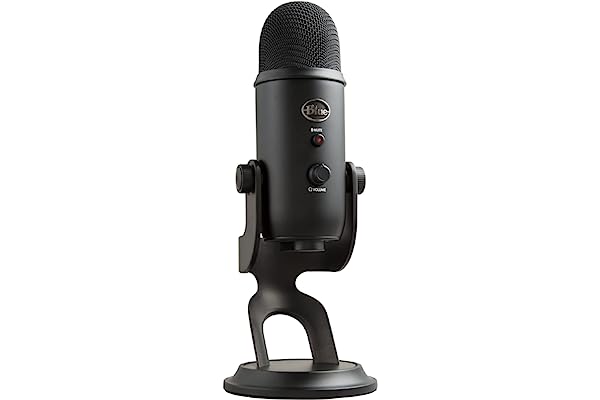Features
RØDE NT1

- Groundbreaking studio condenser microphone that fuses the classic sound signature of the iconic NT1 with patented next-generation technology
- Connect to an audio interface or mixer via XLR, or plug directly into a computer via USB to record studio-grade sound in any setup – an all-in-one digital recording solution for the home or the studio
- Offers the classic warm, silky character, extremely low self-noise and high SPL handling capability that the original is revered for, perfect for a huge range of applications, from voiceovers and guitars to drums and piano
- Features RØDE’s ultra-low-noise, high-gain Revolution Preamp and high-resolution (up to 192kHz) analog-to-digital conversion for crystal-clear digital recordings
- Body machined from high-grade aluminium with nickel plating and military-grade ceramic coating, ensuring its ready to take on the rigours of recording day in, day out
Blue Yeti USB Mic

- Tri-capsule array – 3 condenser capsules can record almost any situation
- Multiple pattern selection – cardioid, bidirectional, omnidirectional & stereo
- Gain control, mute button, zero-latency headphone output
- Perfect for vocals, musical instruments, podcasting, voiceovers, interviews, field recordings, conference calls
Comparing RØDE NT1 5th Generation Large-Diaphragm Studio Condenser Microphone and Blue Yeti USB Mic
Are you in the market for a new microphone? If so, you’ve probably come across the RØDE NT1 5th Generation Large-Diaphragm Studio Condenser Microphone and the Blue Yeti USB Mic. These two microphones are popular choices for music production, vocal recording, and podcasting. But which one should you choose?
In this blog post, we’ll compare the RØDE NT1 and the Blue Yeti to help you decide which microphone is the best fit for your needs. We’ll explore their features, sound quality, and design, and provide a conclusion to help you make an informed decision.
Features
The RØDE NT1 is a large-diaphragm condenser microphone that features an XLR and USB output, a shock mount, and a pop filter. It’s designed for professional-level recording and is compatible with most recording software.
The Blue Yeti, on the other hand, is a USB microphone that features Blue VO!CE effects, four pickup patterns, headphone output, and volume control. It’s designed for both recording and streaming and is compatible with Mac and PC.
Both microphones are plug-and-play, so you don’t need any additional software or hardware. They also both come with adjustable stands, so you can adjust the height and angle of the microphone to suit your needs.
In terms of features, the Blue Yeti has the edge. It offers more options for sound customization, which is great for streamers and podcasters. The RØDE NT1, on the other hand, is more suited for professional-level recording.
Sound Quality
When it comes to sound quality, both microphones deliver crystal-clear audio. The RØDE NT1 is designed to capture subtle nuances and details, making it great for recording vocals and instruments. The Blue Yeti, on the other hand, is designed for streaming and podcasting, so it’s great for capturing conversations and other audio sources.
In terms of sound quality, both microphones are great options. The RØDE NT1 is the better choice for recording, while the Blue Yeti is better suited for streaming and podcasting.
Design
The RØDE NT1 has a sleek, modern design that looks great in any studio setting. It’s also lightweight, making it easy to transport. The Blue Yeti, on the other hand, has a more traditional design and is heavier than the RØDE NT1.
In terms of design, the RØDE NT1 is the better choice. It’s lightweight and modern, making it perfect for recording on the go. The Blue Yeti, on the other hand, is better suited for streaming and podcasting.
Conclusion
The RØDE NT1 and the Blue Yeti are both great microphones. The RØDE NT1 is the better choice for professional-level recording, while the Blue Yeti is better suited for streaming and podcasting.
Ultimately, the choice comes down to personal preference and needs. If you’re looking for a microphone for recording and streaming, the Blue Yeti is a great option. If you’re looking for a professional-level microphone for recording vocals and instruments, the RØDE NT1 is the way to go.
We hope this blog post has helped you decide which microphone is the best fit for your needs. For more information on these microphones, check out the official websites: RØDE NT1 and Blue Yeti.
Specifications / Attributes
| Feature | RØDE NT1 | Blue Yeti USB Mic |
|---|---|---|
| Battery type | N/A | Lithium Ion |
| Colour | Black | BLACKOUT |
| Compatible Devices | Laptop, Personal Computer | Personal Computer, Headphone |
| Connector | USB, XLR Connector | USB |
| Date First Available | 21 February 2023 | 13 November 2017 |
| Hardware Interface | N/A | USB, CD-R Drive |
| Hardware Platform | Laptop | PC |
| Item Model Number | NT1 5th Gen | 988-000448 |
| Item Weight | 308 g | 1.59 kg |
| Material Type | N/A | Metal |
| Output Wattage | N/A | 0.13 Watts |
| Power Source | Corded Electric | Corded Electric |
| Product dimensions | 27.18 x 20.96 x 17.65 cm; 308 Grams | 12.5 x 11.99 x 29.49 cm; 1.59 Kilograms |
| Size | N/A | Mic Only |
| Voltage | N/A | 5 Volts |
| Check the Best Deal Price Today | Check the Best Deal Price Today |







